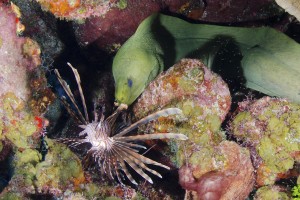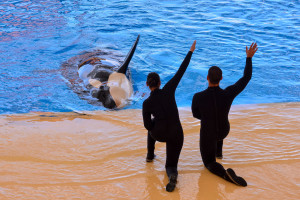Sci-fi fantasy could become a reality for divers who dream of living beneath the surface of the ocean if these forward-thinking projects ever come to fruition.
OCEAN SPIRAL
Billed as “a new interface between humankind and the deep sea,” Ocean Spiral is a wild future-city concept by Japanese engineering corporation Shimizu Corp. designed to solve present-day environmental challenges including shrinking food production, growing energy demand, decreasing freshwater reserves, increasing CO2 emissions and dwindling natural resources.
At the surface, a population up to 5,000 will inhabit the Blue Garden, a floating sphere measuring 1,640 feet in diameter that houses residences, businesses, a hotel, research facilities and other infrastructure in a 75-floor central tower with 360-degree views. Plunging more than 2 miles deep, the Infra Spiral will contain a factory producing power from carbon dioxide using micro-organisms; generators that create energy from seawater through thermal conversion; aquaculture farms to grow food; and a desalinization plant to create fresh water.
At the bottom, the Earth Factory will store CO2 emissions and house a submarine port. Total cost for the self-sustaining city, if built, is estimated at $26 billion, and construction could take five years.
CITY OF MÉRIENS
From the mind of French architect Jacques Rougerie, who also envisioned the Sea Orbiter oceangoing skyscraper, this “universal city” is designed to house an international community of 7,000 scientists, teachers, students and other ocean lovers for extended periods. Measuring almost 3,000 feet long and 1,600 feet wide, the floating structure would offer living quarters, laboratories and classrooms, along with recreation areas and lounge spaces. It’s designed to be self-sustaining and autonomous, running on renewable energy drawn from the surrounding marine environment and leaving behind no waste.
The mantalike design is inspired by the creator’s love for the ocean. “Another type of imagination is awakened in me as soon as I am underwater,” Rougerie told radio station France Inter in 2014.
SUB-BIOSPHERE 2
When Earth becomes uninhabitable due to “a runaway green-house effect, it might be safe living underneath the sea in the long term,” says British designer and futurist Phil Pauley. To preserve all forms of life, the Sub-Biosphere 2 would act as a global seed bank and house 100 people, “the minimum number required to rebuild our species,” Pauley says. In his design, eight biomes recreating Earth’s climatic zones would be arranged around a larger central biome housing integrated life-support systems that link each outer zone to exchange water and air in a manner meant to mimic our planet’s weather. Inside the complex, which measures more than 1,100 feet wide and can be raised or lowered to avoid foul weather or natural disasters, the human inhabitants would interact with each biome to grow hydroponic crops, raise animals, perform research and sustain life as we know it.
 The Cayman Islands is making big waves in its efforts to eradicate the invasive lionfish species that preys in its pristine waters with innovative culling techniques and overpopulation management practices.
The Cayman Islands is making big waves in its efforts to eradicate the invasive lionfish species that preys in its pristine waters with innovative culling techniques and overpopulation management practices.  With the need for good PR rather than the desire for improved animal wellbeing as the motivation behind the new orca shows, it is difficult to believe that the orcas’ situation will significantly improve.
With the need for good PR rather than the desire for improved animal wellbeing as the motivation behind the new orca shows, it is difficult to believe that the orcas’ situation will significantly improve.